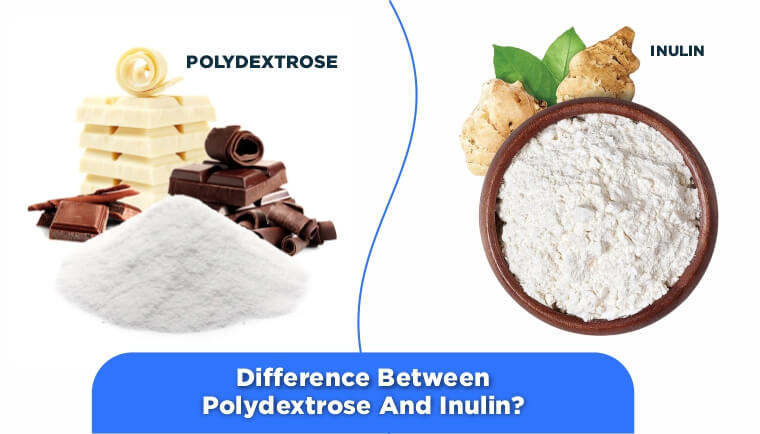
Introduction:
As human beings, glucose is the sugar in our blood that keeps us energetic. When dozens of glucose sugars are joined together, it's called starch. But there are ways glucose units are joined that make them indigestible for humans. For example, we can't derive energy from the grass because the glucose sugars that make up cellulose (which is structurally similar to starch) are linked together by bonds our digestive enzymes cannot break. So, cellulose passes undigested into the colon and is now an insoluble fibre.
However, this scenario was set to change in the mid-1960s. Hans Rennhard, a Pfizer researcher, created a polymer of 89% glucose, 1% citric acid and 10% sorbitol. It magically worked as a soluble fibre! So, after getting a patent in 1973, and additionally FDA approval in 1981, polydextrose was classified as a soluble fibre. There have been several studies that have shown its safety and positive effects on human digestion. So, let’s understand more about polydextrose and inulin.
How do high-fibre diets help?
The current interest in dietary fibre comes from several observations in research that populations consuming diets high in dietary fibre have a lower incidence of chronic diseases. This is in stark contrast to Western countries which consume low-fibre diets.
Also Read- What's dietary fiber? It's the secret ingredient for a healthier gut and better digestion.
Studies show that high consumption of dietary fibre means you have a reduced risk of cardiovascular disease, hypertension, obesity, diabetes and gastrointestinal disorders.
How polydextrose and inulin can contribute to your fibre requirement?
The most recently accepted scientific grouping divides fibre into two categories: dietary and functional. Dietary fibre is found intact in a natural form in oat bran, whole wheat, beans, almonds, peas and other plant-based foods.
Functional fibre refers to both the synthetic variety like polydextrose as well as naturally occurring inulin, which is extracted and purified from chicory roots.
Polydextrose has only 1 kcal/g and has over time become a multipurpose ingredient. It helps manufacturers to increase non-dietary fibre content in food. This happens as polydextrose replaces some part of a brand's fat, sugar and starch.
Food and beverage makers can also use Polydextrose and Inulin to create food products with reduced calories which include beverages, cakes, candies, breakfast cereals, desserts, puddings, and dressings. An important factor drawing the attention of the food industry to the use of polydextrose powder in various applications is its simplicity. The taste is clean and non-sweet as it does not interfere with the flavour of the end product.
Why Polydextrose & Inulin are a Hit with the Health-Conscious?
Generally, consumers are attracted to richer and smoother consistency of food brands. They do not want to taste the fibre. Taste and texture are always the prime concerns when reworking recipes of foods for a health-conscious audience.
For instance, Polydextrose uses are varied and work exceptionally well in foods that require bulking agents. It works well with foods that are traditionally sweet or rich in fat. It can maintain the texture and feel in the mouth that is often lost in the process of avoiding sugar and fat to reduce calories. This mouthfeel is particularly important when replacing fat in biscuits and baked food items. It is this mouthfeel that can make a product a hit in the market.
Major Differences Between Polydextrose & Inulin
Polydextrose and inulin are both types of soluble dietary fibres. They are often used by the food industry to improve the nutritional profile of products. Some key differences between the two are as follows:
Chemical Composition of Polydextrose & Inulin
Polydextrose is a synthetic polymer of glucose. It is created through the polymerization of dextrose which is a kind of simple sugar. Inulin is a natural polysaccharide that belongs to a group of fibres known as fructans.
Root Source of Polydextrose & Inulin
Polydextrose is a synthetic substance. It is usually created through the polymerization of dextrose which is a sugar derived from corn. However, Inulin is found naturally in certain plants, such as chicory roots, dandelion roots and Jerusalem artichokes.
Specific Calories in Polydextrose & Inulin
Polydextrose provides a small amount of calories, but it is considered low in calories as compared to some other carbohydrates. Inulin like polydextrose is generally low in calories.
Texture of Polydextrose and inulin
Polydextrose is highly soluble in water and is often used to improve the texture and mouthfeel of food products. Inulin is also soluble in water and forms a gel-like texture. Inulin provides a creamy texture and is often used as a fat substitute.
Health Advantages of Polydextrose & Inulin
Polydextrose contributes to the dietary fibre content of a product. It helps in digestion and provides a sense of fullness. Polydextrose is often used as a sugar substitute in sugar-free, less calorie-dense products. However, Inulin can lead to the growth of beneficial bacteria in the gut and is often used for its digestive health benefits in certain food brands.
Digestion of Polydextrose & Inulin
Polydextrose is partially fermentable in the colon. However, a large portion can pass through the digestive system without being used. On the other hand, Inulin is very fermentable by the gut microbes. This leads to the production of short-chain fatty acids. This can have various health benefits.
Also Read - Polydextrose: A Low-Carb Sweetener for Diabetics
Final Thoughts
Since obesity and better health is the most popular dietary concern, there are many strategies food brands are using to attract health-conscious consumers. Polydextrose and Inulin have allowed the food industry to add fibre and reduce calories from sugar and fat. Most importantly, this is done without compromising texture or taste.